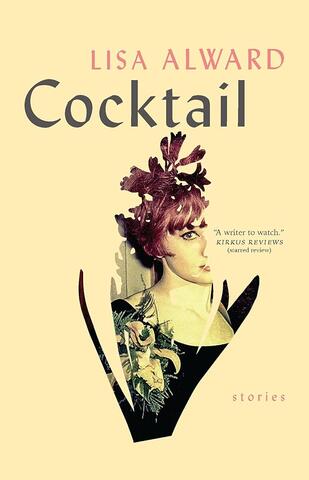
The epigraph to Lisa Alward’s new story collection, Cocktail, is an epiphanic moment from Virginia Woolf ‘s To the Lighthouse, in which the artist Lily Briscoe strives to resurrect and memorialize her dead friend through painting her portrait. Moved to uncharacteristic emotion by a sudden realization of the brevity of life, Lily laments, “Was there no safety? No learning by heart of the ways of the world? No guide, no shelter, but all was miracle, and leaping from the pinnacle of a tower into the air.” The quotation is an apt opening to a remarkably assured debut collection, filled with characters poised at moments of unexpected insight that quietly shatter the assumptions of their apparently stable, unremarkable lives.
About a decade ago, standing at a similar precipice moment in her own life, Alward began to publish short fiction, to immediate success. The title piece of the collection won The Fiddlehead fiction award, and her work has appeared in The New Quarterly, Prairie Fire, untethered, and Exile, as well as the Journey Prize anthology and Best Canadian Stories.
The influence of Woolf, the subject of Alward’s MA dissertation, is apparent in the profound psychological excavations, as well as in unpredictable devices like unexplained mid-story disappearances of seemingly significant characters. A motif of sudden rupture cycles through these stories as protagonists seem doomed to relive moments of pain and disconnection. (Alward will sometimes use section breaks in which action continues without change of time or place, a device that underscores the psychological weight of the pause.) Stylistically, the prose evokes Alice Munro and, perhaps more so, Britain’s Tessa Hadley: a smooth literary style and razor-sharp diction choice. Her writing eschews Baroque flourish in favour of clear, reverberating notes.
Beginning in the sozzled, smoky sixties and spanning to the present day, these twelve stories feature mostly middle-class characters. Settings tend to be domestic interiors or outdoor spaces — forests, gardens, family summer camp vacations, amusement parks — and situations revolve around watershed life events: marriage, babies, broken relationships. Two linked stories explore familial disconnection, the long reverberations of divorce, another rupture. Houses in these stories are seldom safe or comfortable spaces. Seemingly mundane environments conceal complex, often fraught histories. Vivid, precise details like music, brand names, and clothing styles immerse the reader in the material worlds of the characters. The starred Kirkus review of Cocktail describes Alward’s talent at observing “the small horrors of domesticity.” In “Hawthorn Yellow,” for instance, a young couple sets out to renovate a room in their heritage home and must first strip years of built-up wallpaper. The happy project begins with the deadly image of sharp knives and the potent metaphor of scraping away layers. Add a fit handyman to the mix and the story assumes a tense, erotic register.
The title story of the collection evokes the louche glamour of the 1960s Mad Men era — a glamour ultimately unveiled as illusory, empty as a drained cocktail glass. The adult woman narrator remembers an incident from her early teens, when Tom, an inebriated guest at her parents’ cocktail party, enters her bedroom and conducts a menacingly intimate conversation. The taut scene is interrupted by her older brother, David, standing in the doorway “in a crack of light,” but the meeting looms large in her memory and compels her to selfdestructive adult choices as she chases her fantasy of the seductive stranger. Was he real, or fake as the gaudy maraschino cherry in his drink? The story reads equally as a personification or allegory of addiction, and as a realistic story of a watershed encounter. Here, as in other stories, Alward seems concerned with how we make our own choices as we battle forces beyond our control. The narrator remembers a frightening night of sleepwalking and the brief relief of being wakened by her mother, only to feel unsafe again:
I was mistaken. Things were already moving out of place. Only a few months earlier, my mother had moved all her clothes into the guest room. Your father snores, she explained, and as my father’s room took on more of the smell of shoe polish and Old Spice, it seemed as if they had always slept apart. My brother was also on the move, biking through distant neighbourhoods with the Goodwin twins and, when he was home, retreating to his own room with family-sized bottles of Pepsi. Here come the seventies, bragged our television set on Thursday nights. Welcome to the Space Age, to the twenty-hour workweek, no more teachers, no more books. I knew I should feel excited too, yet all this anticipation for what lay just ahead, the sense that life was about to become an endless party, worried me.
“Hyacinth Girl” references a character in The Burial of the Dead, the opening section of T.S Eliot’s famously inscrutable The Waste Land. Laura takes her undergraduate son, Daniel, for a celebratory birthday lunch only to discover he is back in touch with the stepmother who cast a long shadow over their lives. Briony, the now ex-partner of Laura’s former husband, has sent Daniel an alarmingly beautiful pot of hyacinths — gorgeous, showy, temperamental flowers — triggering Laura’s unresolved fears and resentment. “The old malaise swept through her. The sense that there would always be those who got to live in beauty, coming back late with their arms full, and those that didn’t.” Alward explores the no-win détente between women in an imposed rivalry, the self-defeating narratives we build in our own minds, the fragility of confidence and self-knowledge.
And this, Laura realized, in the semi-darkness of her cubicle in Belladonna’s, was what enraged her. Not the duplicity, the gardenvariety adultery and betrayal of marriage vows, not the loss of a husband she no longer even thought about in that way, but the degree to which she’d acquiesced to this idea of a superior hidden life. Let it unfurl inside her, leaf after greedy leaf, even as she saw through Briony’s pretensions, saw how she used beauty and art to cloak her own shallow self-absorption. Yet still unable to counter this sense of being less, of being judged and judging herself as less. A hole plunging open at her feet and dragging her down, holding her firmly in place where she did not want to be — so that all she was left with were the flimsy darts of the injured wife.
The story fearlessly confronts female anger as a valid, examined emotion rather than a hyper-emotional weakness. Traditionally feminine images of flowers become powerful, potentially malevolent organisms. Her tone here is reminiscent of Elena Ferrante’s frank engagement with the complexities of female friendship, allegiance, and confrontation. The brilliant, feather-light twist late in the story brings Laura (and the reader) to the realization that her fear of the “hyacinth girl” is a mirage; the real source of danger is the handful of dust mentioned a few lines earlier in Eliot’s masterpiece.
Significantly, Alward ends her collection with a story of a marriage that endures. In the haunting gem, “How the Smoke Gets in Your Eyes,” an elderly widow gives evidence to a police officer following a break-in and theft at her home, and finds herself reinvestigating her own long, flawed marriage to a chain-smoking journalist. Recalling an on-the-edge moment, she reflects:
Of course, in the moment, it’s hard to know what you should do: whether to leave or stay. A marriage rarely feels so open-and-shut when you’re still in it. Even Brenda, who had far more cause, for a long time wasn’t sure. There seemed to be risks to both, she’s said, and her husband made all the usual promises. It’s like you’re squinting at your life, she told me once. Trying not to see too much. Which made me think of that old Platters song Ted always hopped the needle to. How the smoke gets in your eyes.
The story brings us full circle back to the smoky room in “Cocktail,” with another suggestively empty glass. Squinting through smoke recalls the young narrator’s brother standing in a crack of light, soon to disappear from her view, and her life.
Alward’s stories team with vividly honest portraits of human relationships, and her writerly insight lies in clearly seeing our blind spots.












